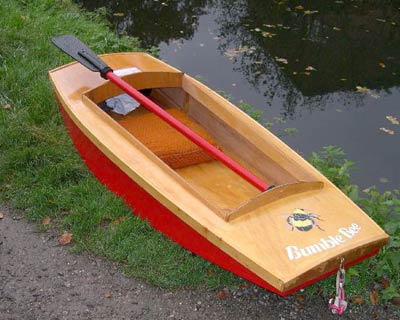I've had a number of requests for a still smaller
Mouse, and the Micro Mouse is it! However, I also wanted to
create a official Mouse with a flat bottom and curved sides
for, although the straight-sided, flat-bottomed Mouse boats
work surprisingly well, I think their looks may well put off
some potential builders. I don't think the curved sides add
all that much extra work just two curved plots to create the
bottom and a few straight bevels to the frames.

Les Brown's MicroMouse "Bumble
Bee"
I had chine logs in mind when drawing up Micro
Mouse because experience has taught me that even quite young
children of eight or nine can enjoy playing a part in building
a boat of that kind - under close supervision I've found they
can plot coordinates, cut framing lumber, and drive galvanised
nails into pre-drilled holes. However, I see no reason why people
should not stitch and glue Micro Mouse if they prefer. I'd suggest,
though, that epoxy is probably not a suitable material for children
to work with.

dimension drawings included in download
I think Micro Mouse could be build in a variety
of ways one might set up the frames on a rigid base, trim them
to accept the sides and internal chine logs; another would be
to build her sharpie-skiff style by attaching the sides to a
temporary 29 1/2 in central frame, then adding the bows and
stern transoms, and then the pre-measured frames (not forgetting
to cut slots in the frames to accept the chine logs of course!).
Naturally, the usual Mouse principle applies to
the decks and gunwales First fasten and glue the half-inch inner
gunwales, then use the hull itself to mark the shape required
for the decks, then cut out and fasten and glue the decks, and
then, finally, add half-inch outer gunwales to cover the ply
edge.

another mouseboat hits the waves
For extreme lightness, I think Micro Mouse might
profitably be built in 1/8in ply and covered in epoxy glass,
and that if material of this thickness is used external chine
logs may be practical.
One last point Micro Mouse will need a skeg, and
it's not yet clear to me how large it will have to be - except
to say that it should be quite large. To make it, I would create
a half-inch wide slot using two half-inch strips of timber fastened
to the aft bottom, and then I'd cut and fit a skeg to fit snugly
in the slot before fastening and glueing it into place. If 1/8in
material is used for the hull, the hull material in way of the
keel should be doubled up once or twice to shore it up.

Les Brown demonstrates his inimitable
paddling style
Gavin
PS If anyone's interested in building this boat,
talking with other builders for advice and support, the Yahoogroup
Mouseboats is a lively and friendly source of information and
inspiration
http//groups.yahoo.com/group/mouseboats

